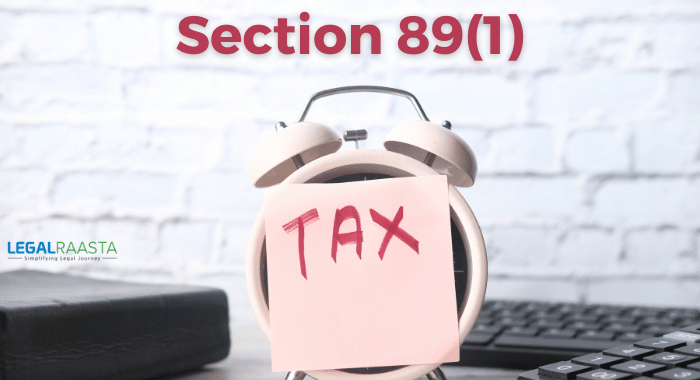Claiming Relief under Section 89(1) on Salary Arrears
Introduction
India has always been a country with an income tax system that is progressive in nature. India follows the principle of “last-in, first-out” (LIFO) to calculate the taxable income. India also allows for certain deductions and exemptions under Section 89(1). One such exemption is salaried arrears which are considered as past dues paid during the current year.
Under Section 89(1), if your total income includes any past dues paid in the current year, you may be worried about paying a higher tax on such arrears (usually, tax rates have gone up over India’s Income Tax Act overtime plus this addition of the previous salary increases your slab rate).
What is relief under section 89(1)?
Total income earned or received during the year is used to determine your tax rate. You may be concerned about paying a higher tax on outstanding arrears if your total income includes any past deductions paid in the current year (usually, tax rates have risen over time and previous earnings raise your tax slab rate).
The tax code allows you to deduct the interest on your loan if it causes a delay in receiving income, as long as you are not in a higher tax bracket at the time. Simply said, you should not have to pay additional taxes because of a payment delay and being in a lower tax rate for the year you received the money.
Section 89(1) relief is available if you have paid your arrears during the current year. The relief is available for dues that were paid in India during the current year and also past dues that were paid in India but not during the current year.
How to calculate tax relief under section 89(1) on salary arrears
If you are eligible for any sort of tax benefit based on section 89(1), you can claim it. This is true even if you are reimbursed for travel expenses, medical bills, or other miscellaneous expenditures in the past. The following are the steps for calculating tax relief yourself – Here’s how to do it –
However, tax relief may be obtained by following a few simple procedures.
Step 1:
Calculate the tax due on the entire income for the year it is received, including any extra compensation. Arrears will be reflected in Part B of Form 16.
Step 2:
Calculate the amount of tax you’ll owe on all earnings, excluding any additional compensation in the year they’re received. The amount of additional salary (Arrears) can be found in your employer’s arrear document, which was supplied to you at the end of the last financial year. You must deduct the arrears from the total salary received (including any arrears), which can be found on your Form 16. This calculation will provide you with a precise amount of tax owing in the current year if there were no arrears.
Step 3:
Subtract Step 1 from Step 2 to get the difference. This will show you how much more tax you’ll have to pay as a result of arrears in income.
Step 4:
To determine how much tax you’ll owe on your entire year’s income, excluding arrears, divide the total amount of arrears by twelve.
Step 5:
Calculate the total tax due on the entire year’s income, including arrears.
Step 6:
Calculate the difference between Steps 4 and 5. This computes the real tax obligation in any prior year relating to arrears received in the current year, as well as full arrears received in the same prior year.
Step 7:
The amount of tax relief that may be granted is the excess of Step 3 over Step 6. If the amount in Step 3 is greater than that in Step 6, no relief will be given. To calculate tax arrears, you may use the steps on the income tax website instead.
Filling Form 10E
Filing Form 10E is a must if you want to take advantage of the tax credits under section 89(1). You may submit this form online using your income tax e-filing portal. To utilize the form, you must first log in to your account.
What is Form 10E?
Starting in the assessment year (2015-16) for income taxes, the revenue department has required all filers to submit Form 10E if they wish to avail themselves of relief under section 89(1).
How to fill Form 10E?
You may submit Form 10E through the internet. Here are the procedures for submitting Form 10E online.:
Step 1: Log in to www.incometax.gov.in with your User ID and password to prepare the return online.
Step 2: Click e-File> Income tax forms > File Income Tax Forms after you’ve logged in.
Step 3: The following screen should display. Select Form-10E from the drop-down menu under “Persons not having any business/professional income.”
Step 4: The following screen should appear. Choose the assessment year and click Continue.
Step 5: The screen that appears below will display. To begin, click the “Let’s Get Started” button to fill out the form.
Step 6: Select the income-related details you wish to have on your invoice. Then go to the ‘Continue’ button if you selected an amount or a percentage from a list.
Step 7: Click on the links in the next screen to fill out the forms for each part.
Step 8: Click on the ‘Preview’ button to see what the completed Form-10E will look like.
Step 9: Continue to the e-verify confirmation page. The transaction ID and acknowledgment receipt number will be shown in the successful submission of the form.
Non-filing of Form 10E results in an income tax notice.
The income tax department has required filing of Form 10E starting with the financial year 2014-15 (the assessment year 2015-16), in order to obtain relief under clause 89(1). Taxpayers who have claimed relief under clause 89(1) but have not filed Form 10E have been contacted by the income tax department, which has provided them–
Because the online form 10E was not submitted by you, the relief under section 89 has been denied in your case. According to sec.89 of the Income Tax Act, the furnishing of Online form 10E is required.
Frequently Asked Questions
Where can I file Form 10E?
Form 10E can be completed online at www.incometax.gov.in.
Which assessment year should I choose while filing Form 10E?
Choose the assessment year in which you received your arrears. If arrears are delivered in 2018-19, choose 2019-20 as an example.
Is Form 10E required to be submitted before or after filing an income tax return?
Before you submit your income tax return, you must submit Form 10E. If you have filed your return but not provided Form 10E, and you qualify for relief under clause 89(1), you are likely to receive a letter from the tax authorities asking you to fill out and submit Form 10E.
Is it necessary for me to include a copy of Form 10E with my tax return?
Tax season is upon us, and many taxpayers are wondering how the new 10E form will affect them. The 2017 Form 10E has to be submitted online, and no duplicate is needed to be attached with your tax return. If you submit Form 10E using the IRS’s e-filing system, no papers are necessary to be given to Clear
Is it necessary for me to submit Form 10E to my boss?
Before adjusting your taxes and providing tax relief, your employer may require confirmation of the Form 10E submission. It is not necessary to submit this form to your employer.
Also Read,
Tax avoidance is lawful; Tax avoidance is criminal
Consequences of Failing to File an Income Tax Return










